
Physics Questions and Answers
If you want to learn more about the nature and properties of matter and energy or you're simply preparing for a Physics exam, these Physics past questions and answers are ideal for you.

If you want to learn more about the nature and properties of matter and energy or you're simply preparing for a Physics exam, these Physics past questions and answers are ideal for you.
The opposition offered to an alternating current in a C-R series circuit is known as
impedance
resistance
reactance
friction
Correct answer is A
No explanation has been provided for this answer.

\(F_{e}\) is attraction while \(F_{g}\) is repulsion
Both \(F_{e}\) and \(F_{g}\) are that of repulsion
Both \(F_{e}\) and \(F_{g}\) is that of attraction
\(F_{e}\) is repulsion while \(F_{g}\) is attraction
Correct answer is D
electrostatic force can be repulsive or attractive and gravitational force is only attractive.
The main reason why a.c. is transmitted at very high voltage and low current is that
flows faster through the conductor
can be stepped down
is cheaper to generate
reduces heat loss
Correct answer is D
No explanation has been provided for this answer.

3.0\(\Omega\); 0.9V
3.0\(\Omega\); 3.0V
3.3\(\Omega\); 0.3V
3.3\(\Omega\); 9.0V
Correct answer is A
E = 3.0V; \(\frac{R}{l} = 10\Omega m^{-1}\)
l = 30cm = 0.3m; R = \(10\Omega m^{-1} \times 0.3m = 3\Omega\)
\(\frac{E}{V} = \frac{l_{1}}{l_{2}} \implies \frac{3}{V} = \frac{1}{0.3}\)
= \(\frac{3\times 0.3}{1} = 0.9V\)
N2.50
N3.20
N6.50
N9.60
Correct answer is A
Power = 100W; Voltage = 240V; Time = 5 hours
Total energy used = Power x time = 100 x 5 = 500wh
converting to kwh, we have
\(\frac{500}{1000} = 0.5kWh \times N5 = N2.50\)